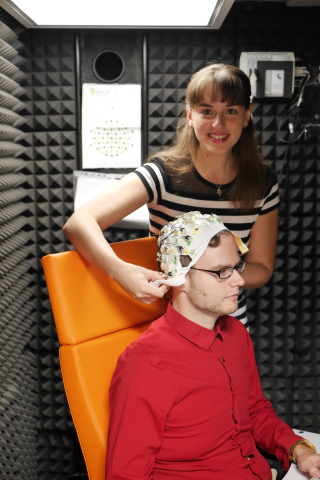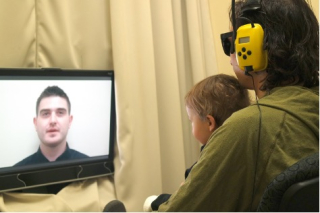MoBI’s research program focuses on four research axes:
1. Acquisition Context and its Relation to Multilingual Performance
We investigate the effects of age and context of second language (L2) acquisition on physiological and brain developmental processes. We also aim to identify potential neural biomarkers of language learning success and failure.
Example investigations in this axis include:
- Examining how linguistic capacity varies in individuals as a function of the context and age of acquisition, as well as how L2 learning can impact a first language through language interaction.
-
Exploring how early exposure to specific phonetic systems that is subsequently discontinued yields long-term influence on speech perception and neural networks by working with international adoptees to obtain electroencephalography and magnetoencephalography data.
-
Shedding light on the functional and structural changes associated with multilingualism and the factors that underlie variability in language learning by combining sophisticated behavioural measures such as eye-tracking with brain imaging.

2. Cognitive & Interpersonal Advantages of Multilingualism Across the Lifespan
We ask whether differences in executive function relate to the moment-by-moment demands of bilingual language processing or other important social variables. We argue, in particular, that to fully understand how bilingualism affects executive control in older adults, future research must embrace the inherent individual variability among bilinguals.
Example investigations in this axis include:
-
Comparing groups of participants with different language-learning contexts and histories, as well as differing levels of proficiency, to identify those characteristics that maximize any advantageous effects of bilingualism and thus maximize benefits to individuals and society.
-
Incorporating measures of language entropy developed by our team to explore the interaction of social interactional factors with language behaviour and brain plasticity.
-
Examining the relationships between multilingualism, cognitive reserve, socio-cultural variables, genetics, and neuroanatomy in persons with or at risk for Alzheimer Disease.

3. Multilingualism and Social Interactions
We study the influence of multilingualism on social network development and the influence of social networks and current patterns of language usage on language learning.
Example investigations in this axis include:
-
Examining how social networks change as second-language (L2) proficiency improves and how interconnectedness within an L2 social environment affects language learning. The size and breadth of social networks are linked to specific languages used, linguistic contexts, and L2 proficiency measures to determine the factors that maximize successful assimilation into society.
-
Developing a specific language entropy metric to quantify language experience as a multidimensional spectrum. It indexes multiple aspects of language experience as well as how bilingual speakers utilize their languages in either a balanced or imbalanced manner across contexts.
-
Using neuroimaging and electrophysiological measures to show that bilinguals recruit a broader network of neural resources to accurately perceive speech in the context of noise depending on their age of acquisition (but not proficiency).

4. Multilingual Exposure in Early Infancy
We aim to build a deeper and more nuanced understanding of how speech communication abilities emerge when children grow up with two or more languages from the start. Our focus is on developing a more sophisticated assessment of infants’ language experiences, and finer-grained knowledge of how the diversity of their experiences impacts language acquisition.
Example investigations in this axis include:
-
Validating the use of the Language ENvironment Analysis (LENA) system in a French-English bilingual infant context and subsequently using LENA to build the Montréal Bilingual Infant corpus, an archive of naturalistic recordings of infants from bilingual French-English families.
-
Identifying how and when bilingual caregivers mix languages and in what contexts when interacting with their infant, as well as how speaker, language, and social contexts influence infant volubility.
-
Using an auditory distraction masking paradigm to assess whether selective attention to speech is enhanced in bilingual infants and whether such effects align with visual processing advantages.



